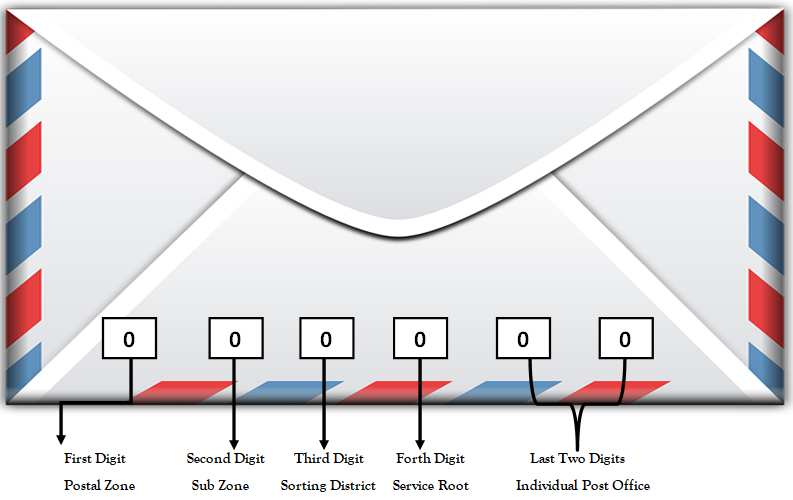Do you ever wonder what the postal index number of India means? Why do we need to write the Postal Index Number (PIN) on the letters or parcels when we send them through a courier company or the postal department? Why postal index number (PIN) is important?
Pin code or postal index number (PIN) of India is a six (6) digit code that India Post uses to sort mail. Shriram BhikajiVelankar introduced the PIN code system in India on August 15, 1972. Nine (9) PIN regions are there in India. Out of 9 regions, the first eight (8) regions are geographic regions and the 9th digit is reserved for the armed forces Postal Service.
The first digit of the PIN refers to one of the zones. The second digit of the PIN indicates a sub-zone. The third digit of the PIN indicates the sorting district. The last three digits indicate the individual Post Office.
Table of Contents
Why Need PIN Codes?
The PIN-code system aims to make it easy for the post office staff to manually sort and deliver letters and parcels by avoiding confusion over the similar names of places and incorrect addresses.
As we all are aware of the fact that India is a big country having 28 states, 8 Union Territories, 738 districts containing about 662051 villages, and more than 8200 towns and cities. So remember the entire PIN codes of every location in the country, city, town, or village or to detect a place with its PIN code is not easy.
So the main reason behind the PIN code system introduction was to provide such a system to the postal department through which they can manually sort and deliver mail (letters, parcels, etc) to the right address and to eliminate the confusion over the similar area names, incorrect addresses and different languages written by people.
The postal index number of India (PIN) is six digits long. PIN codes are generally assigned to geographical areas. But sometimes some institutes and individual addresses like government agencies and big commercial agencies which receive bulk mail are allotted with special codes. An example of such a system is the French CEDEX system.
Thus PIN code helps the post office to sort mail according to their locations. For a postman, these codes help to deliver the mail to the right people.
Also Read: Largest Postal Network in The World: India
Six Digits in Postal Index of India (PIN)
Most people may think that what is the meaning of PIN (postal index number) of India? Why it is necessary to write PIN codes on the letters and parcels? Why do postal and courier services ask us to write the pin code of the address? Whenever addresses are mentioned you may have noticed six-digit figures.
What do these six digits do? Why are these digits important? How do these numbers get there? Let’s try to learn about these six-digit numbers?

First Digit
The first digit of the PIN of India indicates postal zones which start from 1 to 9. There are 9 postal zones in India. So giving these zones a postal index number makes it easy to deliver the mail to the general public.
Second Digit
Postal zones are further divided into sub-regions. The second digit of PIN represents these zones. These sub-regions are usually Union Territories or states. Therefore the second digit of PIN represents the sub-regions which are union Territories and Stares.
Third Digit
This third digit when combined with the first two digits of the postal index number specific geographical region. (Except in the case of the functional zone for the Military/Defense) This geographical region which is indicated by the third digit is known as a sorting district. This region is headquartered at the main post office of the largest city in the region and is called the sorting office.
Forth Digit (Service Routes)
The route on which a delivery post office is located within the sorting district is represented by the fourth digit. The fourth digit is 0 for the offices which are located in the core area of the sorting district. The combined third and fourth numbers are close to the mail sorting district in each state. So the fourth digit of PIN represents the service route of the mail.
Last two digits
The last two I.e. fifth and sixth digits together identify the specific post office under whose jurisdiction the address is located. From 01, which indicates the general post office (GPO) or central office (HO) of the area, this numbering is performed in chronological order and higher numbers are assigned to the new delivery offices. If the volume of mail processed in a delivery office is very high, a new delivery office is created and the next available PIN code is assigned to that office.
First Digit of Postal Index Number of India Shows:
| First Digit of PIN | Region |
Zone |
| 1 | Northern | Delhi, Haryana, Punjab, Himachal Pradesh, Jammu and Kashmir, Chandigarh |
| 2 | Norther | Uttar Pradesh, Uttarakhand |
| 3 | Southern | Rajasthan, Gujarat, Daman and Diu, Dadra and Nagar Haveli |
| 4 | Southern | Maharashtra, Goa, Madhya Pradesh, Chhattisgarh |
| 5 | Eastern | Telangana, Andhra Pradesh, Karnataka |
| 6 | Eastern | Tamil Nadu, Kerala, Puducherry, Lakshadweep |
| 7 | Western | West Bengal, Odisha, Arunachal Pradesh, Nagaland, Manipur, Mizoram, Tripura, Meghalaya, Andaman, and Nicobar Islands, Assam, Sikkim |
| 8 | Western | Bihar, Jharkhand |
| 9 | APO | Army Post Office (APO), Field Post Office (FPO) |
First two (2) Digits of PIN of India Indicates:
| First 2 Digits of PIN | Circle |
| 11 | Delhi |
| 12 to 13 | Haryana |
| 14 to 16 | Punjab |
| 17 | Himachal Pradesh |
| 18 to 19 | Jammu&Kashmir |
| 20 to 28 | Utter Perdash and Uttaranchal |
| 30 to 34 | Rajasthan |
| 36 to 39 | Gujarat |
| 40 to 44 | Maharashtra |
| 45 to 49 | Medhya Perdash and Chattisgarh |
| 50 to 53 | Andhra Pradesh and Telangana |
| 56 to 59 | Karatanakata |
| 60 to 64 | Tamil Nadu |
| 67 to 69 | Kerala |
| 70 to 74 | West Bengal |
| 75 to 77 | Orrisa |
| 78 | Assam |
| 79 | North Eastern |
| 80 to 85 | Bihar and Jharkhand |
| 90 to 99 | Army Postal Service (APS) |
Conclusion
Postal Index Number of India (PIN) refers in India to a code in the numbering system or postal code used by India Post. The code has six digits.
Shriram Bhikaji Velankar starts the PIN code system in India. Its implementation began on 15 August 1972, to simplify mail classification, to speed up the transmission and delivery of mail. So on August 15, 1975, India starts to use the PIN code system.
Each PIN is assigned exactly to a delivery post office that receives all mail for delivery to one or lower offices within its jurisdiction, all these offices share the same code. The delivery office can be a general post office (GPO), a central office (HO), or a secondary office (SO) which is generally located in urban areas.
The post from the delivery office is classified and forwarded to other delivery offices with a different PIN code or to one of the secondary offices or branches concerned for the same PIN code. The branches (BO) are located in rural areas and have limited postal services.


